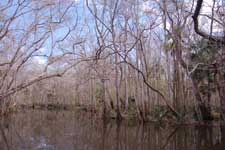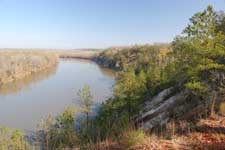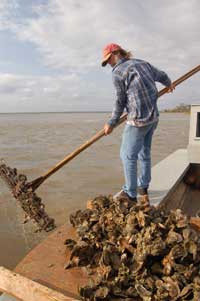|
 Photo Source: Alexa Elliot
Photo Source: Alexa Elliot |
THE FOREST
Located southwest of Tallahassee, the Apalachicola National Forest is the largest national forest in Florida. Rare plants and elusive animals are supported by the many rivers, creeks, and streams that flow through the Apalachicola National Forest. Renowned for its longleaf pine and wiregrass habitats, the forest is home to animals such as the Florida black bear, flatwoods salamander, fox squirrel, and the endangered red-cockaded woodpecker.
|
 Photo Source: Alexa Elliot
Photo Source: Alexa Elliot |
WHO’S BLUFFING?
The Apalachicola Bluffs and Ravines Preserve is a 20-mile stretch of land between the towns of Chattahoochee and Bristol. Rising 135 feet above the Apalachicola River, Alum Bluff, along the preserve’s 3.75 mile long hiking trail, is one of the highest points in Florida. It gives visitors a spectacular view over the Apalachicola River and the area’s enchanting landscape. Unlike clay hills, where water erodes the area’s surface, water from steephead ravines runs out from underneath sand hills and carries soil away. The lower section of the slope, known as a moist hammock, is home to the greatest variety of vegetation within the Preserve. Here, two of the world’s rarest evergreens are found: the Florida yew and the Florida torreya.
|
 Photo Source: Alexa Elliot
Photo Source: Alexa Elliot |
PARADISE WILD
The Apalachicola National Marine Estuary is a collection of barrier islands, estuarine, riverine, floodplain and upland habitats. The most productive estuarine system in the northern hemisphere, and the second largest in the nation, this area supports a vast array of life. Nutrient rich waters make excellent foraging and nursery grounds for fish like snapper, tarpon, grouper, shoal bass and gulf sturgeon. Apalachicola Bay is an important stopping point for our winged friends as well, especially the trans-gulf migrants during spring. However, species from both the Atlantic and Mississippi flyways also find rest and nourishment here. Last but not least, the estuary is home to the highest species density of amphibians and reptiles in the United States and Canada.
|
 Photo Source: Alexa Elliot
Photo Source: Alexa Elliot |
FISHY BUSINESS
Apalachicola’s diverse and unspoiled waters are the lifeblood of this small coastal community. A large portion of its residents, 60-85%, make a living from the region’s fishing industry. Apalachicola is considered the “Oyster Capital of the World,” producing 10% of the nation’s harvest and 90% of Florida’s. Other popular fisheries include shrimp, blue crab and fen fish. But seafood wasn’t always king. During the mid-1850’s, cotton and lumber production was big business, making Apalachicola the third largest port in the Gulf of Mexico.
Resources for this article
have been provided by the FWC, the Nature Conservancy, the Florida Department of Environmental Protection, and the U.S. Fish & Wildlife Service .
|





